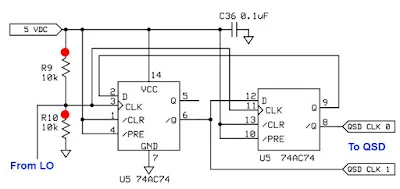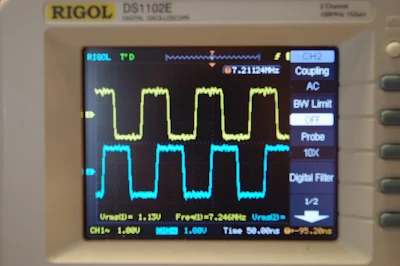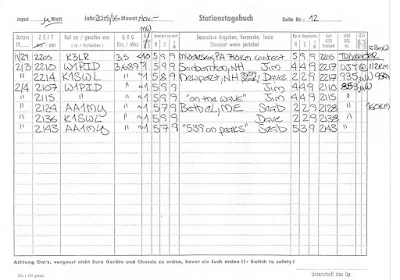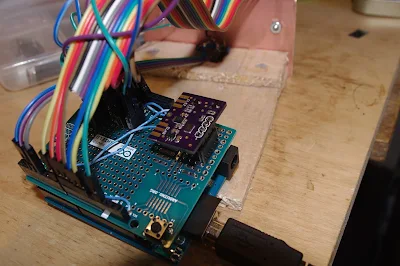Serving the worldwide community of radio-electronic homebrewers. Providing blog support to the SolderSmoke podcast: http://soldersmoke.com
Podcasting since 2005! Listen to our latest pocast here:
Podcasting since 2005! Listen to Latest SolderSmoke
Thursday, February 11, 2016
Gravitational Waves, A GREAT VIDEO, Phasing, and Joe Taylor K1JT
Wow, you really have to spend 20 minutes and watch the video (above). It is really well done. I loved it. I give it FIVE SOLDERING IRONS!
And big news today! They did it! Gravitational waves finally detected. Here is a good New York Times article that includes a recording of the signal, a nice NYT video that has a good explanation (with phasing!) of how lasers are used in the massive detectors, and mention of Joe Taylor, K1JT, whose Nobel Prize winning work contributed to this great discovery.
http://www.nytimes.com/2016/02/12/science/ligo-gravitational-waves-black-holes-einstein.html?partner=rss&emc=rss&_r=0
Life in the Fast Lane: Potato Semiconductor Chips
Even I, with my luddite tendencies and analog preferences, have recently bumped up against the speed limit of 74 series logic chips. The Si5351 chip in the I and Q VFO for my phasing receiver will run up to 160 MHz. But the 74 series inverters and flip flops that I have attached to the output don't seem to want to go beyond about 120 MHz. Our old friend Thomas LA3PNA tells us how to break this speed limit:
http://www.potatosemi.com/
Be sure to go their "Milestones of 74 Series Logic" Page.
I like their explanation of the brand name:
http://www.potatosemi.com/
Be sure to go their "Milestones of 74 Series Logic" Page.
I like their explanation of the brand name:
Wednesday, February 10, 2016
Single Sideband + Carrier -- The Collins KWS-1
Back on 2 February I was on 160 AM with the DX-100, talking to WA4PGI. At the end of our QSO we got a call from a station. I was at first confused -- was this station calling on SSB? Or was he calling on AM? Turns out that he was -- in a way -- on BOTH. K4DBK was -- I think -- running an old Collins KWS-1, the transmit side of the famous Gold Dust Twins. Aptly named: It was built in 1955. 1000 watts output. $2095.00 in 1955. Gold dust indeed.
The really interesting thing about this rig was that it put out CW, SSB and SSB plus the carrier. I think that was what we were hearing from K4DBK. FB.
Does anyone have an e-mail address for K4DBK? I'd like to drop him a line.
Tuesday, February 9, 2016
Back to Divide by 4 -- Big Improvement in Receiver Performance
Thanks for all the comments and advice. I have come to understand the wisdom of divide by 4 IQ circuits.
Fortunately it was very easy to convert the divide by two 74AC74 circuit described earlier to a version of the divide by 4 scheme seen above. (From the SDR Ensemble II Receiver: http://www.wb5rvz.com/sdr/ensemble_rx_ii_vhf/04_div.htm)
This change provided a great way to observe 1) the improvement in the output signals from the VFO and 2) the resulting improvement in receiver performance, especially opposite sideband rejection.
Here are some numbers. I was very pleased to discover that my Rigol scope will measure duty cycle and phase difference. Thanks Rigol!
AD9850 Divide by 4 : 7.212 MHz Duty cycle: 48.3 Phase Difference: 87-90 degrees
Si5351 Divide by 2: 7.212 MHz Duty Cycle 49.6 Phase Difference: 83 degrees
Si5351 Divide by 4 7.212 MHz Duty cycle 49 Phase Difference: 85-90 degrees
Additional improvement came when I switched the power supply to the IQ inverters and Flip Flops. I switched from 3.3 to 5 volts:
Si5351 Divide by 4 7.105 MHz Duty Cycle 49.7 Phase Difference: 90 degrees
When I took the VFO box and put it back in the receiver with the divide by 4 scheme and the 5 volt supply I immediately noticed a big difference in performance. It was obvious that opposite sideband rejection was back to what I had had with the AD9850, perhaps better.
I have a quick and dirty method of measuring opposite sideband rejection: I put an RF signal into the antenna connector. I put the 'scope on the audio output. I tune (on the desired sideband) for 1kHz audio and I measure the output voltage. Then, with the audio gain and RF sig gen output in the same positions, I tune to the opposite sideband, again tuning for 1 kHz, again measuring audio output. With the divide by 4 scheme and the 5 volt supply, the opposite sideband was so weak I had trouble measuring it. I estimate the rejection to be at least 32 db -- this is back in the range of what I had with the AD9850, and significantly better than I had with the divide by 2 scheme.
Now I just need to figure out how to get the Si5351 VFO sketch to tune above 42.94 MHz. For some reason it quits at this point, switching down to 2 kHz output, and keeping me on 30 meters and below.
Thanks again to Todd VE7BPO for a lot of help with the hardware and to Tom AK2B for help with the Arduino code.
Fortunately it was very easy to convert the divide by two 74AC74 circuit described earlier to a version of the divide by 4 scheme seen above. (From the SDR Ensemble II Receiver: http://www.wb5rvz.com/sdr/ensemble_rx_ii_vhf/04_div.htm)
This change provided a great way to observe 1) the improvement in the output signals from the VFO and 2) the resulting improvement in receiver performance, especially opposite sideband rejection.
Here are some numbers. I was very pleased to discover that my Rigol scope will measure duty cycle and phase difference. Thanks Rigol!
AD9850 Divide by 4 : 7.212 MHz Duty cycle: 48.3 Phase Difference: 87-90 degrees
Si5351 Divide by 2: 7.212 MHz Duty Cycle 49.6 Phase Difference: 83 degrees
Si5351 Divide by 4 7.212 MHz Duty cycle 49 Phase Difference: 85-90 degrees
Additional improvement came when I switched the power supply to the IQ inverters and Flip Flops. I switched from 3.3 to 5 volts:
Si5351 Divide by 4 7.105 MHz Duty Cycle 49.7 Phase Difference: 90 degrees
When I took the VFO box and put it back in the receiver with the divide by 4 scheme and the 5 volt supply I immediately noticed a big difference in performance. It was obvious that opposite sideband rejection was back to what I had had with the AD9850, perhaps better.
I have a quick and dirty method of measuring opposite sideband rejection: I put an RF signal into the antenna connector. I put the 'scope on the audio output. I tune (on the desired sideband) for 1kHz audio and I measure the output voltage. Then, with the audio gain and RF sig gen output in the same positions, I tune to the opposite sideband, again tuning for 1 kHz, again measuring audio output. With the divide by 4 scheme and the 5 volt supply, the opposite sideband was so weak I had trouble measuring it. I estimate the rejection to be at least 32 db -- this is back in the range of what I had with the AD9850, and significantly better than I had with the divide by 2 scheme.
Now I just need to figure out how to get the Si5351 VFO sketch to tune above 42.94 MHz. For some reason it quits at this point, switching down to 2 kHz output, and keeping me on 30 meters and below.
Thanks again to Todd VE7BPO for a lot of help with the hardware and to Tom AK2B for help with the Arduino code.
Sunday, February 7, 2016
Ambition, Greed, and Experiments with a Divide by 2 IQ VFO
Fresh from a great success with the use of the M0XPD divide by 4 I and Q VFO in my Frankenstein Phasing Receiver, I got ambitious. And greedy. I wanted more. More frequency coverage. More bands. Divide by 4 can really limit your frequency range. The AD9850 only goes up to 40 MHz. Divide by 4 and you can't even get the 30 meter band.
So I started looking at other options. Si570 looked nice, but here the lower limit was the problem: 10 MHz. Even with divide by 4, that knocks out 160 meters, a band I am very interested in lately, and that seems to sound especially good in a direct conversion receiver.
Once again, the controversial Si5351 was calling my name. It would go down to 8 kHz and up to 160 Mhz. Woo Hoo! If I could build a divide by 2 IQ VFO, I could cover 160-6 meters.
Here is the basic idea. From:
http://www.markimicrowave.com/blog/2015/04/top-7-ways-to-create-a-quadrature-90-phase-shift/
The Flip Flops are set up to change state when the input signal is going up. By putting an inverter at the input of the bottom FF input, in effect you have that one changing state when the input signal is going down. Look at this for a minute or so. Look at the square waves at the bottom. See it? See how it takes an ordinary signal and spits out two signals, one 90 degrees off the other? Pretty cool, don't you think?
With lots of hardware help from Todd VE7BPO, and software help from Tom AK2B (wizards both), I got my Si5351 divide by 2 circuit working today. You can see the resulting I and Q in the picture at the top. But I am discovering that there may have been wisdom behind those divide by 4 circuits. My opposite sideband suppression isn't as good with this /2 scheme as it was with the AD9850 divide by 4. I'm still trying to figure out why. I may have to go back to divide by 4. Stay tuned.
So I started looking at other options. Si570 looked nice, but here the lower limit was the problem: 10 MHz. Even with divide by 4, that knocks out 160 meters, a band I am very interested in lately, and that seems to sound especially good in a direct conversion receiver.
Once again, the controversial Si5351 was calling my name. It would go down to 8 kHz and up to 160 Mhz. Woo Hoo! If I could build a divide by 2 IQ VFO, I could cover 160-6 meters.
Here is the basic idea. From:
http://www.markimicrowave.com/blog/2015/04/top-7-ways-to-create-a-quadrature-90-phase-shift/
With lots of hardware help from Todd VE7BPO, and software help from Tom AK2B (wizards both), I got my Si5351 divide by 2 circuit working today. You can see the resulting I and Q in the picture at the top. But I am discovering that there may have been wisdom behind those divide by 4 circuits. My opposite sideband suppression isn't as good with this /2 scheme as it was with the AD9850 divide by 4. I'm still trying to figure out why. I may have to go back to divide by 4. Stay tuned.
Saturday, February 6, 2016
Michael's Log: AA1TJ Has FIVE Contacts with the Unijunction Transistor at 1-2 milliwatts
Michael writes:
Dear Friends, The UJT transmitter circuit was improved considerably today. The power output has increased to 1.48mW and the start-up "whoosh" is now far less objectionable. It's currently running in beacon-mode at 3687.8kHz. I'll resume "CQing" as soon as I've returned from an hour's walk in the woods. I hoping to work K1QO among others. 73, Mike
Added five QSOs today. Seabury/AA1MY is in Maine...exactly 100 miles from my doorstep. It's wild to think that we made a one-hundred mile radio contact on a unijunction.
Dear Friends, The UJT transmitter circuit was improved considerably today. The power output has increased to 1.48mW and the start-up "whoosh" is now far less objectionable. It's currently running in beacon-mode at 3687.8kHz. I'll resume "CQing" as soon as I've returned from an hour's walk in the woods. I hoping to work K1QO among others. 73, Mike
Added five QSOs today. Seabury/AA1MY is in Maine...exactly 100 miles from my doorstep. It's wild to think that we made a one-hundred mile radio contact on a unijunction.
Friday, February 5, 2016
Beautiful BITX17 Presentation by Chris PA3CRX
This is a really amazing presentation on our beloved BITX rigs. This presentation takes the viewer from block diagram to schematic to photos of the actual circuits and throws in great graphics showing spectra and filter curves etc.
There is no sound.
Here is the link in case the embed above doesn't work:
https://prezi.com/yn2loy4mi0wo/bitx20/
Thanks Chris!
Thursday, February 4, 2016
A Probable First: First Ever Radio Contact Using Unijunction Transistor as the Transmitter
AA1TJ writes:
I spent most of a week working to raise the RF output power from my unijunction transmitter to nearly 1mW. I was rewarded this evening with two contacts.
Jim/W1PID exchanged (599/449) signal reports with me from Sanbornton, NH (112km) at 2210z!
Dave/K1SWL did the same (589/229) from Newport, NH (95km) some four minutes later!
I should think these were the first-ever radio contacts made using a unijunction transistor as the transmitter.
FYI: my receiver was comprised of a single 1N34a germanium diode mixer followed by a single 2N35 germanium transistor audio amplifier. Great signals on this end.
Wikipedia on Unijunction Transistors: https://en.wikipedia.org/wiki/Unijunction_transistor
Wednesday, February 3, 2016
New VFO for the Frankenstein R2 Phasing Receiver
The flip-flop and inverter IC's should arrive this week. That will allow me to finish up this VFO conversion project.
Sunday, January 31, 2016
Dead Chickens and Fake Transistors in Medellin Colombia: HK4DEI's Micro 40 DSB Rig
Daniel HK4DEI wrote to report that page 149 of the SolderSmoke book was providing some solace and comfort as he struggled to get his version of Peter Parker's Micro 40 Double Sideband rig going. He was having problems with the amplifier. He was almost at the point of sacrificing chickens to Papa Legba. I wished him luck and told him to hang in there.
Elisa saw my e-mail to Daniel and complained that I hadn't given him the solution to his amplifier woes. I tried to explain to her that there are sometimes things in this universe that are just UNKNOWABLE. C.F. Rockey W9SCH (who alerted us in SPRAT 22 to the chicken sacrifice option) spoke of transistors that exhibit "quantum mechanical necromancy." Rockey explained that when this happens, "The transistor simply turns up its toes and dies. Not even an Atomic Physicist can tell you why!"
But Daniel persisted. And he won the battle:
Hey Bill
Did you kill some chickens already? If you did, THANK YOU! If you don't, then please enjoy a nice sancocho de gallina for me.
But seriously... guess what?
FAKE TRANSISTORS!!!!
Clear Skies.
73/72 from Colombia!
HK4DEI
Saturday, January 30, 2016
RESISTANCE IS FUTILE! Diode Tunnels in Germany and Vermont
Peter DL3PB's Zinc Negative Resistance Transceiver
Michael Rainey AA1TJ's work with tunnel diode rigs has provided much grist for the SolderSmoke mill over the years, as has the tunneling of Peter DL3PB:
http://soldersmoke.blogspot.com/search?q=tunnel+diodes
They are back at it!
Michael updates Peter (and us!) us on his efforts of this week:
Grüss Peter!
Thanks for the nice message. Yes, I knew that you were going to be QRV with your ZnO transceiver but I never heard if you had made any contacts. I guessed that you had not, otherwise I'm sure you would have let me know.
Again, I think your circuit looks really great! It's amazing to think you managed to squeeze 500uW from a scrap of oxidized zinc-plated steel. Even if you didn't make a contact, what you are doing is really fantastic. Congratulations on the creation of this amazing radio!
Okay, so I spent most of the afternoon at the workbench. Thus far I'm only using a single SRD (step-recovery-diode...1N5401 rectifier). Of course the result is a unipolar pulse. The idea did work as planned, however the power only increased by 2.24dB. The maximum RF output power is now 230uW. At least the SRD makes a pretty pulse :-)
Please find two scope captures attached to this message. The first (0002) shows the SRD generated unipolar pulse. As you can see, the pulse width is nearly perfect for the job. The second trace shows the output RF waveform. The worst spurious energy is ~20dBc. The second image shows the 507kHz waveform at the unijunction emitter along with the output RF waveform.
The beacon is presently off the air, but I look forward to trying my luck tomorrow with a back-to-back pair of SRDs. A bipolar pulse pair will provide a shock impulse once every 3.5 cycles, instead of once every 7 cycles with the present unipolar drive pulse. The bipolar pulse pair should result in increased RF output power as well as a slight spectral improvement.
It's only a matter of time before you make a ZnO QSO, Peter. As we always say, the difficulty merely sweetens the eventual success.
A broadband measurement of my output power (using an AD8307 log-amp power meter) indicates 139uW. Spurious frequency energy accounts for 2uW, leaving 137uW at 3.552MHz. I believe this is roughly the output power produced by your ZnO transmitter?
This morning I'll attempt to increase the unijunction (UJT) 80m RF output power by inserting a pair of back-to-back standard-recovery power supply rectifiers (1N5401-ish) at the UJT base-2 to ground node. Thus far I have relied exclusively on internal UJT nonlinearity for the generation of harmonic energy. I've reason to believe the minority carrier charge-storage capability (normally a defect, but hopefully a virtue here!) of these rectifiers will efficiently produce a bipolar pulse-pair every 1/500kHz seconds resulting in an odd-order comb-spectrum. At least that's the plan...we'll see how it works out ;-)
Peter, I never heard the results of your ZnO DXpedition? Any luck OM?
73,
Mike, AA1TJ
Peter, DL3PB, in Germany respond with amazing news of his own. Peter is homebrewing his own tunnel diodes, using Zinc Negative Resistance Oscillators. No store-bought appliances for him!
At this point you really have to visit the pages of Nyle K7NS
and
Nyle tells of building a little microwatt transmitter, and, once the snow melted, climbing a hill 5 miles from town to see if he could hear it. This reminded me of young Marconi's early efforts in Bologna.
Peter writes:
Hi Folks,
Mike, your plan on how to increase output-power sounds reasonable – yes, a few dB could really help, to make reception a bit steadier and thus allow a QSO.
Well, I thought we had already talked about the ZnO TRX attempt, but obviously we didn’t. The reason is dead simple - It didn’t work.
[ The ZnO TRX is a minimalist 80m band transceiver with a homemade tunnel-detector-diode as the only active device – based on Nyle’s K7NS experimentshttp://sparkbangbuzz.com/zinc-
Three days in a row after Xmas I tried for several hours each, I had announced the activity on QRPSPOTS and the German QRP Forum. Thus several guys
within the right distance were really trying hard to copy. I used different temporary antennas, mostly verticals, but also a sloper dipole - nada, niente , nothing.
One or two OMs reported weak CW signals on the scheduled QRG, but too deep in the noise, to even make out, whether it was me or someone else.
Yes, power is more or less comparable, actually it’s 0.5mW +/-3dB depending on the day’s form of the homemade tunnel-detector, but I guess all my antennas are
some dB behind a full-size dipole, so at the end it’s pretty much the same.
Folks were very cooperative during the test itself, but after it was clear, that it had not worked, the usual trolls showed up to explain, why that never could have worked...
I plan another test within the coming week e.g. during the PA-contest next weekend ( I’m only 30km from the dutch border ) with a base loaded 15m vertical –
be assured, you’re the first to hear about any success in terms of QSO or just being heard anywhere.
What would we go for, if everything works as expected and/or right from the beginning – or as Jim said it : What fun...
Mike, your plan on how to increase output-power sounds reasonable – yes, a few dB could really help, to make reception a bit steadier and thus allow a QSO.
Well, I thought we had already talked about the ZnO TRX attempt, but obviously we didn’t. The reason is dead simple - It didn’t work.
[ The ZnO TRX is a minimalist 80m band transceiver with a homemade tunnel-detector-diode as the only active device – based on Nyle’s K7NS experimentshttp://sparkbangbuzz.com/zinc-
Three days in a row after Xmas I tried for several hours each, I had announced the activity on QRPSPOTS and the German QRP Forum. Thus several guys
within the right distance were really trying hard to copy. I used different temporary antennas, mostly verticals, but also a sloper dipole - nada, niente , nothing.
One or two OMs reported weak CW signals on the scheduled QRG, but too deep in the noise, to even make out, whether it was me or someone else.
Yes, power is more or less comparable, actually it’s 0.5mW +/-3dB depending on the day’s form of the homemade tunnel-detector, but I guess all my antennas are
some dB behind a full-size dipole, so at the end it’s pretty much the same.
Folks were very cooperative during the test itself, but after it was clear, that it had not worked, the usual trolls showed up to explain, why that never could have worked...
I plan another test within the coming week e.g. during the PA-contest next weekend ( I’m only 30km from the dutch border ) with a base loaded 15m vertical –
be assured, you’re the first to hear about any success in terms of QSO or just being heard anywhere.
What would we go for, if everything works as expected and/or right from the beginning – or as Jim said it : What fun...
73!
Peter/DL3PB
Peter/DL3PB
Finally, Alan Wolke provides a very illuminating (as always) explanation of tunnel diodes):
Friday, January 29, 2016
AA1TJ's 150 Microwatts Heard at 112 Kilometers -- "To Boldly Go Where no Unijunction Has Gone Before."
AA1TJ reports:
Breaking news from W1PID... "Mike! I just copied the beacon. I got 'VVV de AA1TJ 150 uw' and it faded out. 2146Z on 3551.95MHz" That's it! Jim copied a message produced by a lowly unijunction at a distance of 112km. How's that for cool! In a nutshell... the unijunction runs as an R-C relaxation oscillator at ~500kHz. A quartz crystal at the emitter frequency-locks the sawtooth waveform to 507kHz. The 7th harmonic is admitted to the antenna via a bandpass filter. The RF output to DC input conversion efficiency is all of 0.1%. Heat-sink? Check! Mission statement:
"...to boldly go where no unijunction has gone before." Cheers,
Mike, AA1TJ
I think the really cool thing is that EM waves are once again flying out of the Vermont Hobbit Hole, propelled into space by the poet laureate of QRP.
Breaking news from W1PID... "Mike! I just copied the beacon. I got 'VVV de AA1TJ 150 uw' and it faded out. 2146Z on 3551.95MHz" That's it! Jim copied a message produced by a lowly unijunction at a distance of 112km. How's that for cool! In a nutshell... the unijunction runs as an R-C relaxation oscillator at ~500kHz. A quartz crystal at the emitter frequency-locks the sawtooth waveform to 507kHz. The 7th harmonic is admitted to the antenna via a bandpass filter. The RF output to DC input conversion efficiency is all of 0.1%. Heat-sink? Check! Mission statement:
"...to boldly go where no unijunction has gone before." Cheers,
Mike, AA1TJ
I think the really cool thing is that EM waves are once again flying out of the Vermont Hobbit Hole, propelled into space by the poet laureate of QRP.
Subscribe to:
Comments (Atom)














